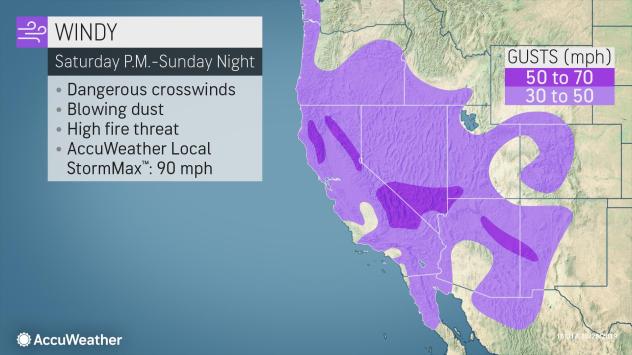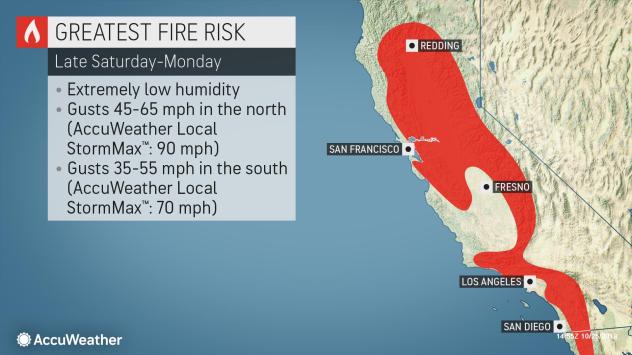After a brief lull, a new round of even stronger winds and extreme fire danger will unfold in California this weekend into early next week.
As a potent storm pushes across the northern Rockies and a strong area of high pressure builds across the Pacific coast and Great Basin, winds will again kick up and wreak havoc for firefighters and residents in California already dealing with several large blazes such as the Kincade Fire in Sonoma County and the Tick Fire in Los Angeles County.

North-to-northeast winds will kick up late Saturday over Northern California and spread to Southern California on Sunday.
The period with the strongest wind in Northern California is expected to be late Saturday night into Sunday afternoon.
Strong winds will also be felt over much of the southwestern United States later this weekend.
North California will bear the brunt of the strongest wind gusts with this next fire weather event, particularly the North Bay mountains around Sonoma and Napa counties north into Lake, Trinity and interior Mendocino and Humboldt counties..

Wind gusts in this region are likely to climb into the 60- to 90-mph range. Elsewhere around the Bay Area, Sacramento Valley and Sierra foothills gusts of 40-60 mph will be common.
Gusty winds are also forecast for Southern California with the highest winds likely from Sunday to Monday.
Over Southern California, this will generally be considered another moderate Santa Ana event, with wind gusts in the mountains and through the canyons and passes generally ranging from 35 to 70 mph.
By JONATHAN J. COOPER and DAISY NGUYEN
A wildfire in California wine country that may have been caused by a high-voltage transmission line called into question Pacific Gas & Electric’s strategy of selectively cutting off power in windy weather to prevent blazes, and could force it to resort to even bigger blackouts affecting millions as early as this weekend.
The repeated shut-offs and the prospect of longer and more widespread ones brought anger down on the utility from the governor and ordinary customers.
“We will hold them to account,” warned Gov. Gavin Newsom, who has repeatedly blasted PG&E — the nation’s largest utility — for what he calls years of mismanagement and underinvestment that have left its grid less resilient.
With dangerously high winds in the forecast this weekend, the utility said it is planning another major shutdown that could hit 2 million people throughout the region starting Saturday night and last up to two days.
The preparations came as firefighters simultaneously battled flames in both Northern and Southern California: the fire amid Sonoma County’s vineyards, and a wind-whipped blaze that destroyed at least six homes in the Santa Clarita area near Los Angeles and led to evacuation orders covering an estimated 50,000 people.
The possible link between the wine country fire and a PG&E transmission line contained grim parallels to the catastrophic fire last year that tore through the town of Paradise, killing 85 people and destroying thousands of homes in the deadliest U.S. fire in a century. State officials concluded that fire was sparked by a PG&E transmission line.
The line that failed this week is newer and should have been more robust, said Michael Wara, director of the climate and energy program at Stanford University. Its failure will probably make PG&E more cautious, which means more widespread blackouts, he said.
No comments:
Post a Comment